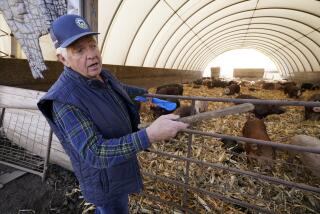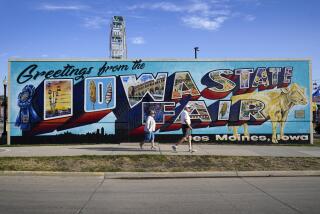A Meaty Issue: Is Today’s Leaner Pork Really ‘the Other White Meat’? : Nutrition: Pig farmers have gone high-tech in their efforts to trim the fat content of their product. But the debate about pork’s qualities continues.
- Share via
RENWICK, Iowa — Harold Trask’s quest for the perfect pig began in 1978. Consumers wanted lean meat and would have nothing else. Pork had to change or face gastronomic oblivion.
“So we bred for lean,” said Trask, a rough-cut hog farmer from the central Iowa flatlands. The idea was to achieve “lean pork”--a linguistic contradiction in terms and a sharp break with tradition in an industry that 40 years ago prided itself on 35 pounds of fat-per-animal “lard hogs” that provided shortening for an entire nation.
But it appears to have worked. Last month the University of Wisconsin, working in conjunction with the hog-raising industry and the U.S. Department of Agriculture, published a study showing that retail pork in 1990 was 31% lower in fat, and had 17% fewer calories and 10% less cholesterol than it did in the USDA’s 1983 nutrient handbook.
The study is not without its detractors. Jayne Hurley, a nutritionist for the nonprofit Center for Science in the Public Interest, said it is misleading.
“Certain cuts are leaner than they were, but how available are they, and how much fat does the average cut of pork have? The study doesn’t tell us.” For these reasons, Hurley said, the industry “has not proved” its claim that pork is “the other white meat.”
But for Russ Sanders, executive vice president of the National Pork Producers Council, the study is a watershed in a decade-long effort to redeem and renovate the nation’s pork supply:
“Pork was the first meat that addressed the fat issue,” said Sanders, whose Council represents 100,000 hog farmers nationwide. “We’re on a product improvement curve that’s probably unprecedented in the business.”
Modesty is not a virtue of an organization whose goal is to make pork “the meat of choice by the year 2000.” They have a way to go, but they are gaining--somewhat.
USDA forecasts that the United States in 1990 will consume 8 million tons of pork and 12.1 million tons of beef, the country’s biggest-selling meat. In 1986, the numbers were 7.6 million tons for pork and 13.2 million tons for beef.
These gains would be more impressive if chicken hadn’t eclipsed them during the same period, with consumption of broilers rising from 6.9 million tons in 1986 to an estimated 8.8 million tons this year.
Barry Pfouts, the council’s vice president for product marketing, nonetheless remains optimistic that “chicken and fish fatigue” will set in. When it does, he says, pork will take up the slack.
In the meantime, the council will continue urging more restaurants to serve more pork to more people, and urging supermarkets to put more pork in more stores. The council has even trademarked its own 1 1/2-inch-thick boneless loin chop as “America’s cut.”
“We’re trying to build some long-lost romance for the product,” Pfouts said. “I mean, let’s face it, raising pigs is not glamorous.”
Few would dispute him. If cattle ranching is outlaws, stampedes and blazing six-guns under the big skies of Marlboro Country, hog farming is a bunch of low-roofed sheds filled with ugly, oinking close-to-the-ground creatures whose chief characteristic lends credence to the phrase: “They stink like pigs.”
“They do smell some,” Trask conceded. “You want to watch your feet.”
The revitalization of the nation’s pork industry began with producers such as Trask, a 44-year-old Iowa State University graduate who started hog farming in 1972 with 10 sows and 320 acres of rented land.
Today he has 220 sows, each of which produces an average of 2.26 litters per year of eight to 10 piglets each for a total of about 4,200 pigs for market, averaging from 220 to 260 pounds. He sells 50 to 90 pigs per week, depending on the price. Every transaction, as well as the medical and growth history of every animal he owns, is registered with a computer company he has under contract. The firm presents him with a weekly printout.
“I’ve got a reputation for knowing the markets better than anyone,” Trask said. “It’s nerve-wracking. I spend about an hour a day seriously looking at the market, maybe two. I don’t market perfectly, but I’m in the top third.”
The hog farmer as commodity broker is one break with the past. Another is the relative importance that farmers accord their pigs. Thirty years ago, swine were an afterthought--animals that would eat some of the extra feed corn that Iowa and other Midwestern states produce in such astonishing abundance.
Today, raising pigs is so sophisticated that farmers cannot afford simply to let their charges run loose in the yard all day. Most Iowa pig farmers grow corn, but the pigs are what take the time and effort.
“I make about half my income from pork and half from grain,” Trask said. “But, yeah, I consider myself a pork producer.”
Trask lives on his family’s 120-acre farm in Renwick, about 100 miles north of Des Moines, and conducts his business in a clutch of nondescript buildings divided into compartments dedicated to each stage of pig development: breeding, birthing, weaning, growing and “finishing”--readying pigs for market.
Native intelligence and skill brought Trask some early success, but in 1978 he began to take an interest in leaner pigs. Lard was passe, and pork had begun a slide into obscurity, what the council’s Sanders calls “two dried-out pork chops to feed the kids on Wednesday night.”
To overhaul the product, Trask and his peers became geneticists, able to juggle breeds, bloodlines and family trees in a continuing search for the perfect animal. Trask today can bewilder the casual questioner in about 30 seconds, but his essential message is simple: Breeding leaner pigs is easy; breeding lean pigs that are good reproducers is harder.
“Five, six years ago we had the leanest animals that we ever had,” Trask said. “But they couldn’t survive because they couldn’t move. We had to breed back for a freer-muscled pig.”
More to Read
Eat your way across L.A.
Get our weekly Tasting Notes newsletter for reviews, news and more.
You may occasionally receive promotional content from the Los Angeles Times.










